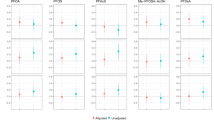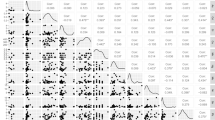Abstract
Ingestion has been a primary route of PCB exposure for people, especially those not working directly in industrial settings. During 2002–2004, women were recruited at delivery from two districts in eastern Slovakia: Michalovce with high PCB contamination from a chemical manufacturing plant, and Svidnik located 70 km to the northwest, having lower environmental levels of PCBs. Concentrations of 15 PCB congeners were measured in maternal serum using high-resolution gas chromatography with electron capture detection. A food frequency questionnaire was developed and validated at the Research Institute of Nutrition and School of Medicine in Bratislava, Slovakia. The questionnaire was comprised of 88 food items representative of the national dietary habits and designed to ascertain (1) the source of food items as reported by the women (locally produced or purchased from a retail outlet) and (2) quantities consumed of high-fat food categories representative of the national dietary habits. Our primary goal was to identify specific food sources, either locally produced or purchased from retail stores, that might predict serum concentrations of PCBs. We used multiple linear regression to examine the relationship of dietary fats to lipid-adjusted serum PCB levels in 948 adult women (Michalovce N=662, Svidnik N=284) who had recently given birth. We adjusted for residential district, age, body mass index, education and duration of previous lactation. Consumption of fat from locally produced foods was significantly associated with higher levels of lipid-adjusted serum PCB (β=0.06, P=0.007). Fat from foods purchased in retail outlets showed no significant association (β=−0.02, P=0.36). There was no interaction between district and diet in predicting serum PCB levels. Comparing women in Michalovce consuming 20 g of fat per day from local sources with those consuming 1 g of fat per day from local sources, lipid-adjusted serum concentrations were predicted to be higher by 81 ng/g lipid or 14.8% 630 ng/g lipid versus 549 ng/g lipid.
This is a preview of subscription content, access via your institution
Access options
Subscribe to this journal
Receive 6 print issues and online access
$259.00 per year
only $43.17 per issue
Buy this article
- Purchase on Springer Link
- Instant access to full article PDF
Prices may be subject to local taxes which are calculated during checkout
Similar content being viewed by others
References
Akins J.R., Waldrep K., and Bernert Jr J.T. The estimation of total serum lipids by a completely enzymatic “summation” method. Clin Chim Acta 1989: 184(3): 219–226.
Babinska K.B., and Bederova A. Changes in nutrient intake in the adult population of the Slovak Republic. J Food Compost Anal 2002: 15(4): 359–365.
Bernard A., Broeckaert F., De Poorter G., De Cock A., Hermans C., Saegerman C., et al. The Belgian PCB/dioxin incident: analysis of the food chain contamination and health risk evaluation. Environ Res 2002: 88(1): 1–18.
Bjerregaard P., Dewailly E., Ayotte P., Pars T., Ferron L., and Mulvad G. Exposure of Inuit in Greenland to organochlorines through the marine diet. J Toxicol Environ Health A 2001: 62(2): 69–81.
CDC. Third National Report on Human Exposure to Environmental Chemicals, 2005.
Chovancova J., Kocan A., and Jursa S. PCDDs, PCDFs and dioxin-like PCBs in food of animal origin (Slovakia). Chemosphere 2005: 61(9): 1305–1311.
Conka K., Drobna B., Kocan A., and Petrik J. Simple solid-phase extraction method for determination of polychlorinated biphenyls and selected organochlorine pesticides in human serum. J Chromatogr A 2005: 1084(1-2): 33–38.
Deutch B., Pedersen H.S., and Hansen J.C. Dietary composition in Greenland 2000, plasma fatty acids and persistent organic pollutants. Sci Total Environ 2004: 331(1–3): 177–188.
Food Research Institute. Slovak Food Composition Bank, 2005.
Furberg A.S., Sandanger T., Thune I., Burkow I.C., and Lun E. Fish consumption and plasma levels of organochlorines in a female population in Northern Norway. J Environ Monit 2002: 4(1): 175–181.
Glynn A., Aune M., Darnerud P.O., Cnattingius S., Bjerselius R., Becker W., et al. Determinants of serum concentrations of organochlorine compounds in Swedish pregnant women: a cross-sectional study. Environ Health 2007: 6: 2.
James R.A., Hertz-Picciotto I., Willman E., Keller J.A., and Charles M.J. Determinants of serum polychlorinated biphenyls and organochlorine pesticides measured in women from the child health and development study cohort, 1963-1967. Environ Health Perspect 2002: 110(7): 617–624.
Jan J.A., and Adamic M. Polychlorinated biphenyl residues in foods from a contaminated region of Yugoslavia. Food Addit Contam 1991: 8(4): 505–512.
Johansen P., Muir D., Asmund G., and Riget F. Human exposure to contaminants in the traditional Greenland diet. Sci Total Environ 2004: 331(1–3): 189–206.
Kim M., Kim S., Yun S., Lee M., Cho B., Park J., et al. Comparison of seven indicator PCBs and three coplanar PCBs in beef, pork, and chicken fat. Chemosphere 2004: 54(10): 1533–1538.
Kocan A., Petrik J., Drobna B., and Chovancova J. Levels of PCBs and some organochlorine pesticides in the human population of selected areas of the Slovak Republic. I. Blood. Chemosphere 1994: 29(9–11): 2315–2325.
Kocan A., Petrik J., Jursa S., Chovancova J., and Drobna B. Environmental contamination with polychlorinated biphenyls in the area of their former manufacture in Slovakia. Chemosphere 2001: 43(4–7): 595–600.
Korrick S.A., Altshul L.M., Tolbert P.E., Burse V.W., Needham L.L., and Monson R.R. Measurement of PCBs, DDE, and hexachlorobenzene in cord blood from infants born in towns adjacent to a PCB-contaminated waste site. J Expo Anal Environ Epidemiol 2000: 10(6 Part 2): 743–754.
Longnecker M.P., Wolff M.S., Gladen B.C., Brock J.W., Grandjean P., Jacobson J.L., et al. Comparison of polychlorinated biphenyl levels across studies of human neurodevelopment. Environ Health Perspect 2003: 111(1): 65–70.
Lopez-Carrillo L., Torres-Sanchez L., Moline J., Ireland K., and Wolff M.S. Breast-feeding and serum p,p'DDT levels among Mexican women of childbearing age: a pilot study. Environ Res 2001: 87(3): 131–135.
Muckle G., Ayotte P., Dewailly E.E., Jacobson S.W., and Jacobson J.L. Prenatal exposure of the northern Quebec Inuit infants to environmental contaminants. Environ Health Perspect 2001: 109(12): 1291–1299.
Paris-Pombo A., Aronson K.J., Woolcott C.G., and King W.D. Dietary predictors of concentrations of polychlorinated biphenyls in breast adipose tissue of women living in Ontario, Canada. Arch Environ Health 2003: 58(1): 48–54.
Persky V., Turyk M., Anderson H.A., Hanrahan L.P., Falk C., Steenport D.N., et al. The effects of PCB exposure and fish consumption on endogenous hormones. Environ Health Perspect 2001: 109(12): 1275–1283.
Petrik J., Drobna B., Pavuk M., Jursa S., Wimmerova S., and Chovancova J. Serum PCBs and organochlorine pesticides in Slovakia: age, gender, and residence as determinants of organochlorine concentrations. Chemosphere 2006: 65(3): 410–418.
Rylander L., Stromberg U., and Hagmar L. Decreased birthweight among infants born to women with a high dietary intake of fish contaminated with persistent organochlorine compounds. Scand J Work Environ Health 1995: 21(5): 368–375.
Rylander L., Stromberg U., and Hagmar L. Dietary intake of fish contaminated with persistent organochlorine compounds in relation to low birthweight. Scand J Work Environ Health 1996: 22(4): 260–266.
SAS. SAS/STAT Software Version 9.1 Cary, NC, USA 2004.
Steuerwald U., Weihe P., Jorgensen P.J., Bjerve K., Brock J., Heinzow B., et al. Maternal seafood diet, methylmercury exposure, and neonatal neurologic function. J Pediatr 2000: 136(5): 599–605.
Walkowiak J., Wiener J.A., Fastabend A., Heinzow B., Kramer U., Schmidt E., et al. Environmental exposure to polychlorinated biphenyls and quality of the home environment: effects on psychodevelopment in early childhood. Lancet 2001: 358(9293): 1602–1607.
Weisskopf M.G., Anderson H.A., Hanrahan L.P., Kanarek M.S., Falk C.M., Steenport D.M., et al. Maternal exposure to Great Lakes sport-caught fish and dichlorodiphenyl dichloroethylene, but not polychlorinated biphenyls, is associated with reduced birth weight. Environ Res 2005: 97(2): 149–162.
Acknowledgements
This project has been funded by the following sources: NIH no. R01-CA96525, no. P01-ES11269, no. R01-ES015359 and EPA STAR Grant no. R829388, and no. RD-83154001, and no. UL1 RR024146 from the National Center for Research Resources. We gratefully acknowledge the ongoing assistance from our Scientific Advisory Board, including Dr. Michael Alavanja, Aake Bergman, Allen Silverstone, John Vena, Don Patterson and Gerhard Winneke.
Author information
Authors and Affiliations
Corresponding author
Rights and permissions
About this article
Cite this article
Sonneborn, D., Park, HY., Babinska, K. et al. Serum PCB concentrations in relation to locally produced food items in eastern Slovakia. J Expo Sci Environ Epidemiol 18, 581–587 (2008). https://doi.org/10.1038/jes.2008.1
Received:
Accepted:
Published:
Issue Date:
DOI: https://doi.org/10.1038/jes.2008.1
Keywords
This article is cited by
-
Gene expression signatures in PCB-exposed Slovak children in relation to their environmental exposures and socio-physical characteristics
Environmental Science and Pollution Research (2022)
-
The spatial distribution of human exposure to PCBs around a former production site in Slovakia
Environmental Science and Pollution Research (2015)



